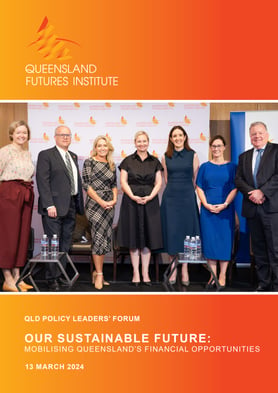
|
Elizabeth Rose
- Queensland’s economy is based on our plentiful natural resources, spanning mineral
and resources, the natural capital of the Great Barrier Reef, our plentiful sun and wind,
fertile land and vast forests.
- These natural assets underpin the diversity of Queensland’s economy and support the
mining, tourism, fisheries, forestry, and renewable energy industries. They also provide
the biodiversity which Queensland is known for.
- Our economy is deeply connected to natural capital, but this is not appropriately valued
in investment decision making. As we face the twin crises of climate change and
biodiversity loss within our economy, it is critical to consider these natural assets into
the future as we continue to grow a prosperous Queensland economy.
|

|
Maree Adshead
- The biggest natural capital investment opportunity in Queensland is the
Great Barrier Reef.
- The reef is valued at around $56 billion, supports 64,000 jobs, and contributes
$6.4 billion annually to the economy.
- However, poor water quality is the second largest threat to the reef’s health behind
climate change. This is why the Commonwealth and Queensland Governments
have set targets to enhance water quality by reducing soil sediment (by 25%) and
dissolved inorganic nitrogen (by 60%) by 2025.
- Meeting these targets has been estimated to cost $8.2 billion to achieve and will
require more than grant funding or regulatory intervention alone. There is a significant
role for market development around sustainable opportunities which will contribute
to protecting our natural capital.
- One example of this is the Reef Credit Scheme, which has been instrumental in
pioneering environmental markets and testing the robustness of their methodologies
for six years. The Scheme is a standard that sets out the rules, eligibility and
accounting methodologies to value and quantify outcomes – which in this case is
removing one kilogram of dissolved inorganic nitrogen or 538 kilograms of sediment.
We independently audit and administer the scheme to measure and verify pollutant
reduction. This process results in the issuance of reef credits, which are tradable
certificates – not unlike a carbon credit – that correspond to a verified outcome. Projects
and the Reef Credits generated are tracked through our publicly accessible Registry.
- Through this process, we have identified several barriers around the effectiveness
of the scheme and scaling investment, including insufficient methodologies and
difficulty in engaging landholders. This results in difficulties in generating the supply
of reef credits which results in inability to balance the market and achieve the desired
outcomes, regardless of the amount of investment we can attract.
- There is a strong need for better explanatory material to educate participants on the
opportunity of this market and ensure robust certificate supply. On the demand side,
government investment in credits would provide a strong signal and boost market
confidence in the integrity of this market.
- While the Queensland Government has committed $10 million to reef credits,
there remains a significant financing gap which must be met in order to meet
the estimated $8.2 billion required to achieve the work and activities required
to protect the reef.
|

|
Anna Marsden
- The biggest natural capital investment opportunity in Queensland right now is in
nature repair markets.
- Queensland possesses significant and iconic natural assets, including the Great
Barrier Reef, making it crucial to protect and repair our natural capital.
As such, there is a unique opportunity for Queensland to lead in crafting
investment programs beneficial for nature, business, and society.
- While there is a lot of work which needs to be undertaken to support terrestrial
ecosystems, the Great Barrier Reef Foundation is focused on coastal ecosystems
– which includes ‘blue carbon’ initiatives, and protecting mangroves, sea grass and
wetlands – and marine ecosystems particularly in combating coral bleaching events.
- The goal is to create a circular, conservation economy where nature repair and
conservation initiatives are funded by nature capital investors rather than relying
solely on government support. This would see Traditional Owners, tourism operators
and regional communities supporting activities which protect the reef and generate
marine biodiversity credits.
- Barriers to supporting and scaling these initiatives include the lack of critical
technology, methodologies and capabilities needed to build a robust and deep market
and attract the investment required.
- Additionally, developing these initiatives and markets will require partnership and
collaboration across various sectors. NGOs and environmental conservation groups
will play a critical role in bringing valuable local knowledge and expertise to facilitate
and scale these natural capital investment programs.
|

|
Professor Mark Brown
- The biggest natural capital investment opportunity in Queensland, from a forestry
perspective, lies in managing the significant amounts of land currently utilised for
agriculture, timber production, forest management, and grazing.
- Land managers are interested in diversifying land use for both commercial outcomes
and long-term sustainability, and already have a very strong base of knowledge
around the opportunities to diversify land uses and protect natural capital.
- Convincing land managers to adopt new practices to protect natural capital will require
building on existing knowledge of communities and First Nations by empowering
them with new information, skills, and technology. This collaborative approach to
land management will support dual outcomes in both primary use and well as carbon
reduction or biodiversity.
- A key barrier to this is the challenge of ensuring the stability of legislation and policy
required to facilitate long-term investment. This is particularly relevant for forestry
given the multi-decade commitment of land managers.
- As such, providing stability and confidence through future policy is essential to unlock
these investment opportunities.
|

|
Katrina King
- QIC manages $100bn for our clients, with a significant footprint in Queensland assets. This includes $13bn in infrastructure and $5bn in real estate, as well as private debt and equity and recently, natural capital.
- We consider that natural capital investments are critical for solving energy
transition and biodiversity challenges at scale. This is why we have established the
Queensland Natural Capital Fund in partnership with the Queensland Government.
- The fund aims to stack returns, ensuring investors receive appropriate risk-adjusted
returns by including agricultural commodity returns, which comprises a significant
component of the fund given the strength and complementarity of this asset class
with natural capital investments.
- Agriculture is considered a robust asset class, and its value proposition is bolstered
by a growing global population and protein demand, but with finite arable land.
These strong supply and demand factors will continue to underpin the prices of
agricultural commodities.
- Through the fund’s stewardship, we ensure investments are managed to deliver
sustainable outcomes, including biodiversity benefits, carbon offsets, water quality,
and soil quality improvements.
- The markets and opportunities around these outcomes are still nascent and cannot
currently be comprehensively measured. As such, the fund offers a risk-adjusted
return reflective of these conditions, which may eventually grow toward
larger returns.
- Queensland is favoured for natural capital investments due to supportive political
landscape, from both State and Federal Governments. This is particularly important for
technology investments – which is exemplified through our investments into AgTech.
- It is also blessed with a vast land area, of which 88% is pasto ral land. This presents
significant propensity and opportunities for generating carbon credits. For scale,
the size of the opportunity in this area is six times larger than New South Wales or
Victoria, and five times larger than Western Australia. This is driven by the state’s
biodiversity, diverse ecosystems, climate, and rainfall, which all contribute to its
potential for natural capital investment.
|

|
Nicole Bradford
- As a superannuation fund, our primary goal is to help our members retire well with
confidence, with approximately 65% of our more than 2.3 million members located in
Queensland. ART works with approximately 120,000 employers across Queensland
to help their employees with superannuation obligations.
- We manage over $280bn in assets globally, with over half of these funds invested in
Australia and several billion dollars invested in public and private markets
in Queensland.
- While we invest in various asset classes – including private equity and credit, listed
equities, fixed income, infrastructure and property – natural capital is not currently
included as one of our defined asset classes, given the need to seek risk-adjusted
returns for our members.
- We balance ESG considerations with our obligation to invest in accordance with
members’ best financial interests. As such, our Sustainable Investment Policy and
Net Zero 2050 Roadmap guide our current approach. In practice, this sees ART
focusing on stewardship and ESG integration throughout the investment process.
- We engage with companies and assets to seek to promote environmental, social,
and governance outcomes, and assess fund managers based on their integration of
ESG factors into investment decisions. This process sets the expectation that fund
managers consider the different parameters of ESG which are financially material.
- Queensland Treasury’s recently released sustainability report shows ambition and
targets for climate change and natural capital, but implementation will be crucial
to realising these ambitions. Investors require certainty and opportunities with
appropriate risk-adjusted returns to effectively deploy capital, highlighting
the importance of implementation for realising these sustainability targets.
|

























